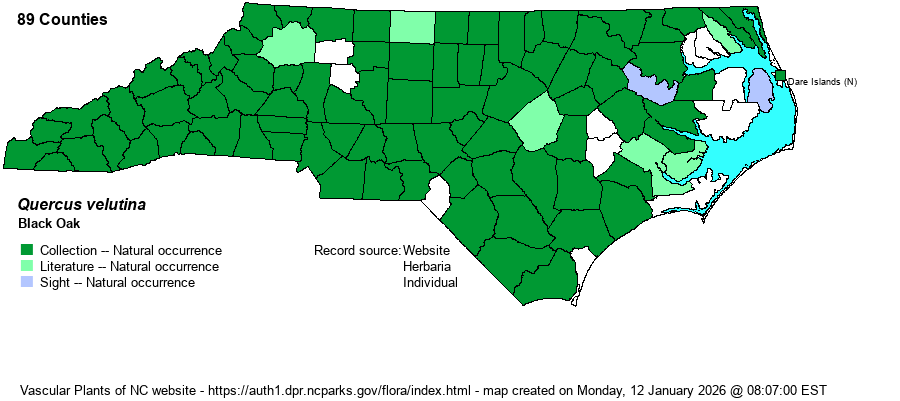| Author | Lamarck | |
| Distribution | Essentially statewide, but as with many oaks it is scarce and local in the far eastern counties, though it may be present in all 100 counties. Certainly present in all counties elsewhere.
This is a widespread Eastern species, ranging from ME to MN on the north, to northern FL and eastern TX on the south. It has been reported from most counties within this huge range.
| |
| Abundance | This is a common and widespread oak across the Mountains, Piedmont, and most of the Coastal Plain. It is rare to infrequent in some far eastern counties, where suitable dry/upland soils can be limited. | |
| Habitat | This species favors dry upland soils and is a major component of the Dry Oak-Hickory Forest natural community, as well as a few other upland forested communities. The soils can also be somewhat sandy or rocky, as well, but not in deep sands. The soils are usually acidic but can be somewhat circumneutral, as well; it can often be a major component of the relatively scarce Basic Oak-Hickory Forest natural community. |
| Phenology | Flowers in April and May, and flowers from September to October of the second year. | |
| Identification | This is a familiar though easily confused medium to large deciduous tree, reaching 80-90 feet, rarely taller. The bark is fairly dark gray to blackish, darker in color than most similar species in the “red oak” group, at least in uplands. The leaves are medium to large, containing several fairly deep and rounded sinuses on each side, yielding an elliptical to obovate leaf with mostly several somewhat square-ish lobes. The leaves are thick, shiny dark green above and with some hairs on the yellowish-brown underside. In general, similar upland oaks of the ”red oak” group -– mainly Scarlet Oak (Q. coccinea) and Northern Red Oak (Q. rubra) -– have thinner leaves that are not dark green and glossy above. Scarlet Oak leaves usually have deeper sinuses, and Northern Red Oak has shallow and more triangular sinuses. Shumard Oak (Q. shumardii) can have similar leaves, but this tree grows on very rich soil of bottomlands and lower slopes on circumneutral soil. Note that Black Oak is notorious for hybridizing with other oaks, and also that the lowest leaves, and leaves on saplings, tend to be quite large and broad, and can look like those of Northern Red Oak. You should try to look at leaves on the middle and upper part of the tree, as well as the color of the bark -– almost blackish; the others have gray bark. | |
| Taxonomic Comments | None
| |
| Other Common Name(s) | Eastern Black Oak | |
| State Rank | S5 | |
| Global Rank | G5 | |
| State Status | | |
| US Status | | |
| USACE-agcp | | |
| USACE-emp | | |

